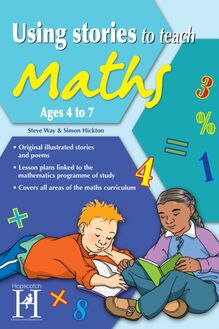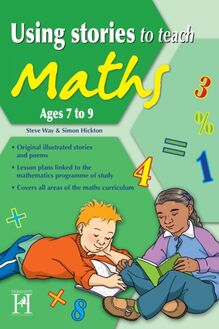Using Stories to Teach Maths Ages 7 to 9 , livre ebook
130
pages
English
Ebooks
2012
Vous pourrez modifier la taille du texte de cet ouvrage
Obtenez un accès à la bibliothèque pour le consulter en ligne En savoir plus
Découvre YouScribe et accède à tout notre catalogue !
Découvre YouScribe et accède à tout notre catalogue !
130
pages
English
Ebooks
2012
Vous pourrez modifier la taille du texte de cet ouvrage
Obtenez un accès à la bibliothèque pour le consulter en ligne En savoir plus
Title page
Using stories to teach Maths
Ages 7–9
Steve Way & Simon Hickton
Copyright page
Published by
Hopscotch, a division of
MA Education,
St Jude’s Church, Dulwich Road,
London, SE24 0PB
www.hopscotchbooks.com
020 7738 5454
©2011 MA Education Ltd.
Written by Steve Way & Simon Hickton
Illustrated by Emma Turner,
Fonthill Creative, 01722 717057
All rights reserved. This resource is sold subject to the condition that it shall not, by way of trade or otherwise, be lent, hired out or otherwise circulated without the publisher’s prior consent in any form of binding or cover other than that in which it is published and without a similar condition, including this condition, being imposed upon the subsequent purchaser.
No part of this publication may be reproduced, stored in a retrieval system, or transmitted, in any form or by any means, electronic, mechanical, photocopying, recording or otherwise, without the prior permission of the publisher, except where photocopying for educational purposes within the school or other educational establishment that has purchased this book is expressly permitted in the text.
Every effort has been made to trace the owners of copyright of material in this book and the publisher apologises for any inadvertent omissions. Any persons claiming copyright for any material should contact the publisher who will be happy to pay the permission fees agreed between them and who will amend the information in this book on any subsequent reprint.
Introduction
Hello! We hope you enjoy using this book and that the ideas in it help add to your toolbox of resources for teaching mathematics.
About the series
The main idea behind “Using Stories to teach Maths Age 7 to 9” is to provide a way of looking at maths that the children have to learn in school from a fresh angle. This means that their learning can be enhanced by looking at maths ideas in different ways. Using the stories can be a fun way of helping the children with their learning and their revision. It also helps children to understand maths by encountering it in different contexts, such as the imaginary situations in the stories and in real-life situations. Every different way in which a child (or an adult!) comes across a maths concept enhances a child’s ability to learn and understand the concept and to remember it. The age categories we have put each story in are of course only a guide as all children are different and they can be of interest and use to older or younger children in the same or different contexts.
By making maths fun the barriers to learning that they often create (“I can’t do maths”, “maths is boring” or similar phrases that they may have picked up from others) can be dissolved and the children gain more confidence and facility to understand and use mathematical concepts and this can lead to a far more positive approach and attitude to the rest of their mathematical learning. Having used these stories and poems in many schools around the UK, we are confident that the children will enjoy engaging with them and learning from them.
Reading the stories
The stories and poems in the book have been written and road-tested over a number of years in schools across the UK. They were originally written using the Mathematics Programme of study as a guide to provide ideas for pieces we could write. For this reason we hope that between them the stories and poems can provide a resource for initiating or supporting work for many of the learning objectives of the Mathematics Programme of study. In the teacher’s notes we also suggest follow up work, often incorporating worksheets or the illustrations that accompany the pieces, which you can use to create a whole lesson around each piece. Of course suggested lesson plans are only a guide and so you can pick and choose the suggestions and ideas that will work best in your school, with your class etc.
When you read the children the story we recommend that you read them the story twice. The first time as a story in its truest sense – a story they can listen to and enjoy as a piece of narrative, without it being broken up and dissected as it’s told. Hopefully the enjoyment they get from the story will enhance their enjoyment of the mathematics they are learning. However on the first reading of the story, they may have been so involved in the plot etc that they miss some of the maths ideas that are used in the story. So on the second reading you can get the children to focus on the maths ideas that weave into the story by stopping at the points where a new concept enters into the narrative and discussing its role in the story, using an enlarged copy. This also means that the children will be able to enjoy seeing – and learning from! – the illustrations and many of the children will enjoy reading the story with you.
Using the lesson plans
Within the planning we have added reference statements headed WALT, WILF and TIB as these or similar systems are often used to ensure lessons are focussed, objective led and in context for the learner. They help summarise the purpose of the lesson, what is required of the children in order for them to successfully learn that lesson, and why what they are learning is important.
WALT stands for “We Are Learning Today.”
WILF stands for “What I’m Looking For.”
TIB stand for “This Is Because.”
The worksheets sheets are designed to support the learning the children are making in mathematics. We recognise that completing them will often require literacy skills, which in some cases the children will not have at the required level. In order that the work remains focussed on mathematics we suggest that you, your classroom assistants etc scribe for such children so that their capability in mathematics is not held back by specific difficulties with literacy.
We hope you enjoy using this book and would welcome all positive suggestions/criticisms that might enhance future volumes!
Finally we’d like to mention that many of the stories are based around a character called the Wise Wizz of Woo. Although many legends, most of them untrue, are told regarding this remarkable character, there are a few that we have been able to establish for certain. Although indisputably wise, he was not a wizard. He was however a wiz at mathematics. He lived a long long time ago (even before teachers were invented in fact – hurray!) hence his need to actually invent number shapes we use today, as none existed before and he used them to create living numbers and teach them to count in the correct order before being used by people. He had (or has!?!) a time machine. He loved (loves?) strawberry jam. (Hope this helps.)
Contents
Round Up Rebellion
A story about rounding up numbers to nearest 100, nearest 10. King Hundreds and King Tens eventually run away from a battle thinking they have fewer men than their opponents. They don’t but they insist on having numbers rounded to the nearest hundred and ten to their disadvantage.
Maths theme: Rounding to nearest ten and nearest hundred.
Dodgy Divisions
A story exploring division as grouping or sharing. Mr Big, the “Boss” of a gang of thieves keeps wanting to share the twelve gold bars they’ve stolen unfairly. Most of the time “Smarts” sees through his tricks, though “Heavy” and “Heavier” don’t!
Maths theme: Fair and unfair sharing/division.
Here go the Guitar Gnoffs
A problem-solving adventure where recognising patterns and relationships saves the day! Also involves simple algebraic problems e.g. # represents 3 (only more interesting) etc.
Maths theme(s): Problem-solving exploring patterns and relationships.
Decimal Dilemma
This story “explains” the reasons for using £.p notation for money. The Wise Wizz of Woo relates three stories where different monetary systems didn’t work as well as our decimal system.
Maths theme: The decimal system of using money.
Shapes Poem/Love Quadrilateral/The Unsquare Square
Poems and other pieces about 2D shapes.
Maths theme: Exploring 2D shapes.
Right Angle Tangle
A “news report” incorporating different angles.
Maths theme: Different types of angle.
Mad Measures
A story where inappropriate measures keep being used (e.g. metre stick to measure a road) to explore relationships between familiar units of length, mass, capacity and time.
Maths theme: Using sensible units of measurement.
One Out of Two People
A story looking at equivalent fractions i.e. one out of two people represents the same fraction as two out of four people.
Maths theme: Equivalent fractions.
Contradictory Comparative Commentaries
A sketch using comparatives about a boxing match. Two different commentators prefer different boxers and begin having a fight! (Bigger/smaller etc.)
Maths theme: Use of comparatives.
Galaxy for Sale
A science-fiction story incorporating use of maths symbols <, > and = as well as different forms of fractions and shapes. The evil Merde is trying to destroy our galaxy (by inverting the flow of time) to produce rare elements that he can sell in other galaxies. Only an alien mother and her two children may be able to stop him!
Maths theme(s):
Chapter 1: Comparisons and mixed numbers
Chapter 2: Inverses and 2D shapes
Chapter 3: Comparing fractions and large numbers
Chapter 4: 3D shapes.
Times Table Poems
The x7 and x8 tables in rhyme!
Maths theme(s): Multiplication tables.
Metric v. Imperial Poem
A poem comparing metric with imperial measurements.
Maths theme(s): Metric and imperial measurements.
Round up Rebellion
KS2. Ma 2. 2c. … round integers to the nearest


